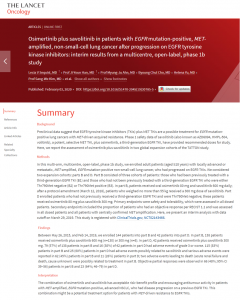- Chi-Med
- News & Presentations
- | Presentations
The Lancet Oncology: Osimertinib plus Savolitinib in EGFRm+, MET+ NSCLC
Osimertinib plus savolitinib in patients with EGFR mutation-positive, MET-amplified, non-small-cell lung cancer after progression on EGFR tyrosine kinase inhibitors: interim results from a multicentre, open-label, phase 1b study
Lecia V Sequist; Ji-Youn Han; Myung-Ju Ahn; Byoung Chul Cho; Helena Yu; Prof Sang-We Kim; James Chih-Hsin Yang; Jong Seok Lee; Wu-Chou Su; Dariusz Kowalski; Sergey Orlov; Mireille Cantarini; Remy B Verheijen; Anders Mellemgaard; Lone Ottesen; Paul Frewer; Xiaoling Ou; Geoffrey Oxnard
Summary
Background
Preclinical data suggest that EGFR tyrosine kinase inhibitors (TKIs) plus MET TKIs are a possible treatment for EGFR mutation-positive lung cancers with MET-driven acquired resistance. Phase 1 safety data of savolitinib (also known as AZD6094, HMPL-504, volitinib), a potent, selective MET TKI, plus osimertinib, a third-generation EGFR TKI, have provided recommended doses for study. Here, we report the assessment of osimertinib plus savolitinib in two global expansion cohorts of the TATTON study.
Methods
In this multi-arm, multicentre, open-label, phase 1b study, we enrolled adult patients (aged ≥18 years) with locally advanced or metastatic, MET-amplified, EGFR mutation-positive non-small-cell lung cancer, who had progressed on EGFR TKIs. We considered two expansion cohorts: parts B and D. Part B consisted of three cohorts of patients: those who had been previously treated with a third-generation EGFR TKI (B1) and those who had not been previously treated with a third-generation EGFR TKI who were either Thr790Met negative (B2) or Thr790Met positive (B3). In part B, patients received oral osimertinib 80 mg and savolitinib 600 mg daily; after a protocol amendment (March 12, 2018), patients who weighed no more than 55 kg received a 300 mg dose of savolitinib. Part D enrolled patients who had not previously received a third-generation EGFR TKI and were Thr790Met negative; these patients received osimertinib 80 mg plus savolitinib 300 mg. Primary endpoints were safety and tolerability, which were assessed in all dosed patients. Secondary endpoints included the proportion of patients who had an objective response per RECIST 1.1 and was assessed in all dosed patients and all patients with centrally confirmed MET amplification. Here, we present an interim analysis with data cutoff on March 29, 2019. This study is registered with ClinicalTrials.gov, NCT02143466.
Findings
Between May 26, 2015, and Feb 14, 2019, we enrolled 144 patients into part B and 42 patients into part D. In part B, 138 patients received osimertinib plus savolitinib 600 mg (n=130) or 300 mg (n=8). In part D, 42 patients received osimertinib plus savolitinib 300 mg. 79 (57%) of 138 patients in part B and 16 (38%) of 42 patients in part D had adverse events of grade 3 or worse. 115 (83%) patients in part B and 25 (60%) patients in part D had adverse events possibly related to savolitinib and serious adverse events were reported in 62 (45%) patients in part B and 11 (26%) patients in part D; two adverse events leading to death (acute renal failure and death, cause unknown) were possibly related to treatment in part B. Objective partial responses were observed in 66 (48%; 95% CI 39–56) patients in part B and 23 (64%; 46–79) in part D.
Interpretation
The combination of osimertinib and savolitinib has acceptable risk–benefit profile and encouraging antitumour activity in patients with MET-amplified, EGFR mutation-positive, advanced NSCLC, who had disease progression on a previous EGFR TKI. This combination might be a potential treatment option for patients with MET-driven resistance to EGFR TKIs.
Citations and Links
Please follow the link below to access the publication:
Lancet Oncol. 2020 Mar;21(3):373-386. doi: 10.1016/S1470-2045(19)30785-5. Epub 2020 Feb 3.
DOI: https://doi.org/10.1016/S1470-2045(19)30785-5
Link to article: https://www.thelancet.com/journals/lanonc/article/PIIS1470-2045(19)30785-5/fulltext
